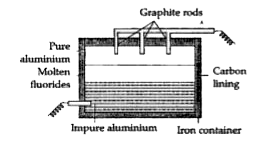Electrolysis is a reaction caused of
light
heat
electricity
both heat and light
The correct Answer is:C
Step-by-Step Solution:
1. Understanding Electrolysis:
Electrolysis is a chemical process that uses electricity to drive a non-spontaneous reaction. It involves the breakdown of a compound into its individual elements or ions.
2. Components of Electrolysis:
In an electrolytic cell, there are two electrodes:
- Anode: The positive electrode where oxidation occurs.
- Cathode: The negative electrode where reduction occurs.
3. Connection to Power Source:
The electrodes are connected to an external power source, typically a battery. The positive terminal of the battery connects to the anode, and the negative terminal connects to the cathode.
4. Migration of Ions:
When electricity is applied, cations (positively charged ions) migrate towards the cathode, while anions (negatively charged ions) migrate towards the anode. For example, in the case of sodium chloride (NaCl), Na⁺ will move towards the cathode, and Cl⁻ will move towards the anode.
5. Reactions at Electrodes:
- At the Anode: Oxidation occurs. For example, Cl⁻ ions lose electrons to form Cl₂ gas.
- At the Cathode: Reduction occurs. For example, Na⁺ ions gain electrons to form sodium metal (Na).
6. Conclusion:
Therefore, electrolysis is a reaction caused by the application of electricity, which facilitates the movement of ions and the subsequent oxidation and reduction reactions at the electrodes.
---
Electrolysis is a chemical process that uses electricity to drive a non-spontaneous reaction. It involves the breakdown of a compound into its individual elements or ions.
In an electrolytic cell, there are two electrodes:
- Anode: The positive electrode where oxidation occurs.
- Cathode: The negative electrode where reduction occurs.
The electrodes are connected to an external power source, typically a battery. The positive terminal of the battery connects to the anode, and the negative terminal connects to the cathode.
When electricity is applied, cations (positively charged ions) migrate towards the cathode, while anions (negatively charged ions) migrate towards the anode. For example, in the case of sodium chloride (NaCl), Na⁺ will move towards the cathode, and Cl⁻ will move towards the anode.
- At the Anode: Oxidation occurs. For example, Cl⁻ ions lose electrons to form Cl₂ gas.
- At the Cathode: Reduction occurs. For example, Na⁺ ions gain electrons to form sodium metal (Na).
Therefore, electrolysis is a reaction caused by the application of electricity, which facilitates the movement of ions and the subsequent oxidation and reduction reactions at the electrodes.
Topper's Solved these Questions
- ELECTROLYSISBook:ICSEChapter:ELECTROLYSISExercise:QUESTION
Explore 3 Videos
- ELECTROLYSISBook:ICSEChapter:ELECTROLYSISExercise:WORK SHEET -1
Explore 17 Videos
- ELECTROLYSISBook:ICSEChapter:ELECTROLYSISExercise:QUESTIONS FOR PRACTICE
Explore 65 Videos
- CHEMISTRY-2015Book:ICSEChapter:CHEMISTRY-2015Exercise:SECTION-II (40 Marks) Attempt any four questions from this Section.
Explore 49 Videos
- METALLURGYBook:ICSEChapter:METALLURGYExercise:UNIT TEST PAPER 6 - Metallurgy (Select the correct answer from the list A,B,C & given in each statement.)
Explore 5 Videos
Similar Questions
Knowledge Check
If 54 g of silver is deposited during an electrolysis reaction, how much aluminium will be deposited by the same amount of electric current?
A(a) 2.7 gB(b) 4.5 gC(c) 27 gD(d) 5.4 g
The following question relate to the extraction of aluminium by electrolysis:

Give the equation for the reaction that takes place at the cathode.
View SolutionThe following questions related to the extraction of aluminium by electrolysis :
Give the equation for the reaction that takes place at cathode.
View SolutionThe following questions relate to the extraction of aluminium by electrolysis :
Give the equation for the reaction that takes place at the cathode.
View SolutionThe following question relate to the extraction of aluminium by electrolysis.
Give equation for the reaction that takes place at the cathode.
View SolutionComplete the reactions for electrolysis of concentrated sodium chloride using steel cathode and graphite anode

View SolutionUse of electrolysis is .
View SolutionFaraday's laws of electrolysis are related to :
View Solution
